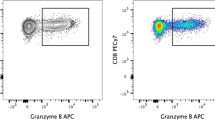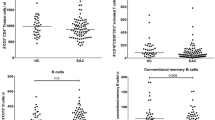Abstract
The aim of this study was to quantify and characterise the CD4+ and CD8+, CD45RA+, CD45RO- T-lymphocytes that paradoxically expressed the CD29 bright+ phenotype in health and in rheumatoid arthritis. We further evaluated their clinical implications. Blood samples were obtained from 100 patients with rheumatoid arthritis and 40 age- and sex-matched controls. Cell surface antigens and interleukin-2 (IL-2) binding were detected on CD4+ and CD8+ peripheral blood T-lymphocytes (T-PBL) by three-colour flow cytometry. One-third of the patients were clinically evaluated at the time of blood sampling. In healthy donors, we found 16 ± 14% of CD29 bright+cells among CD4+, CD45RA+, RO-T-PBL. These “false naive” CD4+ T-PBL were Leu-8+, and a majority expressed the CD25/p55 receptor (IL-2Rα chain), while a minority showed the CDlla bright+, CD69+ and/or CD 122/p75+ (IL-2Rβ chain) phenotype, and few cells were CD31 bright+ and HLA-DR+. In rheumatoid arthritis, their proportion among CD4+, CD45RA+, RO- cells increased to 25 ± 15% (P < 0.001, compared with controls). In patients, the reductions in CD31 and CD38 expression (P < 0.05 for both), as well as the enhanced CD25 expression (P < 0.001) on CD4+, CD45RA+, RO- T-PBL reflected a more differentiated phenotype. The occurrences of CD25 and CD122 were increased on false naive CD4+ T-PBL (0.01 <P<0.001); however, the binding of IL-2 remained very low (in contrast to the binding of IL-2 on CD45RO+ T-PBL). Furthermore, a major subset of CD8+, CD45RA+, RO- T-PBL (45 ± 17% in controls) expressed the CD29 bright+ phenotype. These “false naive” CD8+ T-PBL included a great many of CID 1lb+, CD28- cells, while a minority showed the HLA-DR+, CD69+ and/orCD122+ phenotypes. Patients with low levels of IgM rheumatoid factors (IgM-RF; but with active disease) had an elevated proportion of CD45RA+, RO-cells among the CD8+ T-PBL, in part due to an increased proportion of false naive cells (P < 0.05). In patients, the false naive CD8+ T-PBL showed down-regulated CD1lb and an increased expression of IL-2 receptor chains (CD25 and CD 122; 0.05 <P < 0.01), but without a significant increase in IL-2 binding. More CD69 on false naive CD8+ T-PBL was found in patients with high levels of IgM-RF (P < 0.005 compared to patients with low 19M-RF). Finally, both false naive CD4+ and CD8+ T-PBL correlated with the clinical process and outcome variables (0.05 <P <0.01). The levels of activated false naive CD4+ T-PBL (CD25+ and/or CD122+) or CD8+ T-PBL (CD69+ and/or CD122+) were associated with clinical parameters of disease activity (0.05 <P < 0.01). Thus, in rheumatoid arthritis, false naive T-PBL showed important qualitative differences. The levels of activated false naive T-PBL could be particularly interesting for monitoring disease evolution.
Similar content being viewed by others
References
Clement LT (1992) Isoforms of the CD45 common leukocyte antigen family: markers for human T-cell differentiation. J Clin Immunol 12:1–10
Sanders ME, Makgoba MW, Sharrow SO, Stephany D, Springer TA, Young HA, Shaw S (1988) Human memory T lymphocytes express increased levels of three cell adhesion molecules (LFA-3, CD2, and LFA-1) and three other molecules (UCHLI, CDw29, and Pgp-1) and have enhanced INF-gamma production. J Immunol 140:1401–1406
Pilarski LM, Yacyshyn BR, Jensen GS, Pruski E, Pabst HE (1991) Beta 1 integrin (CD29) expression on human postnatal T cell subsets defined by selective CD45 isoform expression. J Immunol 147:830–837
Worner I, Matutes E, Beverley PC, Catovsky D (1990) The distribution of CD45R, CD29 and CD45RO (UCHL1) antigens in mature CD4 positive T-cell leukaemias. Br J Haematol 72:370–375
Kahan A, Hamzaoui K, Ayed K (1992) Abnormalities of T lymphocyte subsets in Behçet's disease demonstrated with antiCD45RA and anti-CD29 monoclonal antibodies. J Rheumatol 19:742–746
Okumura M, Fujii Y, Inada K, Nakahara K, Matsuda H (1993) Both CD45RA+ and CD45RA- subpopulations of CD8+ T cells contain cells with high levels of lymphocyte function-associated antigen-1 expression, a phenotype of primed T cells. J Immunol 150:429–437
June CH, Ledbetter JA, Linsley PS, Thompson CB (1990) Role of the CD28 receptor in T-cell activation. Immunol Today 11:211–216
Calabrese LH, Taylor JV, Wilke WS, Segal AN, Valenzuela R, Clough JD (1990) Response of immunoregulatory lymphocyte subsets to methotrexate in rheumatoid arthritis. Cleve Clin J Med 57:232–237
Neidhart M, Fehr K, Pataki F, Michel BA (1996) The levels of memory (CD45RA-, RO+) CD4+ and CD8+ peripheral blood T-lymphocytes correlate with IgM rheumatoid factors in rheumatoid arthritis. Rheumatol Int 15:201–209
Neidhart M, Pataki F, Fehr K (1995) Increased soluble endothelial adhesion molecules in rheumatoid arthritis correlate with circulating cytokines and depletion of CD45RO+ T-lympho cytes from blood stream. Schweiz Med Wochenschr 125:424–428
Arnett FC, Edworthy SM, Bloch DA, McShane DJ, Fries JF, Cooper NS, Healy LA, Kaplan SR, Liang MH, Luthra HS, Medsger TA Jr, Mitchell DM, Neustadt DM, Pinals RS, Schaller JG, Sharp JT, Wilder RL, Hunder GG (1988) The American Rheumatism Association 1987 revised criteria for the classification of rheumatoid arthritis. Arthritis Rheum 31:315–324
Williams HJ, Willkens RF, Samuelson CO Jr, Alarcon GS, Guttadauria M, Yarboro C, Polisson RP, Weiner SR, Luggen ME, Billingsley LM, Dahl SL, Egger MJ, Reading JC, Ward JR (1985) Comparison of low-dose oral pulse methothrexate and placebo in the treatment of rheumatoid arthritis: a controlled clinical trial. Arthritis Rheum: 28:721–730
Taniguchi T, Minami Y (1993) The IL-2/IL-2 receptor system: a current overview. Cell 73:5–8
Torimoto Y, Rothstein DM, Dang NH, Schlossmann SF, Morimoto C (1992) CD31, a novel cell surface marker for CD4 cells of suppressor lineage, unaltered by state of activation. J Immunol 148:388–396
Morimoto C, Schlossman SF (1993) Human naive and memory T cells revisited: new markers (CD31 and CD27) that help define CD4+ T cell subsets. Clin Exp Rheumatol 11:241–247
Emery P, Gentry KC, MacKay IR, Muirden KD, Rowley M (1987) Deficiency of the suppressor inducer subset of T lymphocytes in inflammatory rheumatic diseases. Am J Med 84:817–825
Raziuddin S, Nur MA, Alwabel AA (1989) Selective loss of the CD4+ inducers of suppressor T cell subsets (2H4+) in active systemic lupus erythematosus. J Rheumatol 16:1315–1319
Maurer D, Felzmann T, Holter W, Petera P, Smolen J, Knapp W (1992) Evidence for the presence of activated CD4 T cells with naive phenotype in the peripheral blood of patients with rheumatoid arthritis. Clin Exp Immunol 87:429–434
Oshashi Y, Takeshita T, Nagata K, Mori S, Sugamura K (1989) Differential expression of the IL-2 receptor subunits, p55 and p75 on various populations of primary peripheral blood mononuclear cells. J Immunol 143:3548–3555
Nakamura Y, Nakamura T, Tokuda Y, Kobayashi N, Watanabe K, Noto T, Mitomi T, Sugamura K, Habu S (1991) MacrophageT cell interaction is essential for the induction of p75 iinterleukin 2 (IL-2) receptor and IL-2 responsiveness in human CD4+ T cells. Jpn J Cancer Res 82:257–261
Yagita H, Nakata M, Azuma A, Nitta T, Takeshita T, Sugamura K, Okumura K (1989) Activation of peripheral blood T cells via the p75 interleukin 2 receptor. J Exp Med 170:1445–1450
Okumura M, Fujii Y, Takeuchi Y, Inada K, Nakahara K, Matsuda H (1993) Age-related accumulation of LFA-1 high cells in a CD8+ CD45RA high T cell population. Eur J Immunol 23:1057–1062
Niguma T, Sakagami K, Kawamura T, Haisa M, Fujiwara T, Kusaka S, Uda M, Orita K (1991) Expression of the interleukin 2 receptor beta chain (p75) in renal transplantation — applicability of anti-interleukin-2 receptor beta chain monoclonal antibody. Transplantation 52:296–302
Testi R, Philips JH, Lanier LL (1989) Leu-23 induction as an early marker for functional CD3/T cell antigen receptor, triggering: requirement for receptor cross-linking, prolonged elevation of intracellular [Ca++] and stimulation of protein kinase C. J Immunol 142:1854–1859
Maino VC, Suni MA, Ruitenberg JJ (1995) Rapid flow cytometric method for measuring lymphocyte subset activation. Cytometry 20:127–133
Vandenberghe P, Verwilghen J, Van Vaeck F, Ceuppens J'L (1993) Ligation of the CD5 or CD28 molecules on resting human T cells induces expression of the early activation antigen, CD69 by a calcium- and tyrosine kinase-dependent mechanism. Immunology 78:210–217
Author information
Authors and Affiliations
Rights and permissions
About this article
Cite this article
Neidhart, M., Pataki, F., Schönbächler, J. et al. Flow cytometric characterisation of the “false naive” (CD45RA+, CD45R0-, CD29 bright+) peripheral blood T -lymphocytes in health and in rheumatoid arthritis. Rheumatol Int 16, 77–87 (1996). https://doi.org/10.1007/BF01816439
Received:
Accepted:
Issue Date:
DOI: https://doi.org/10.1007/BF01816439




